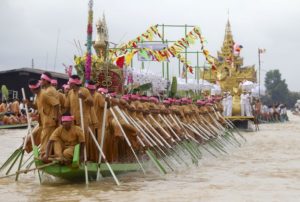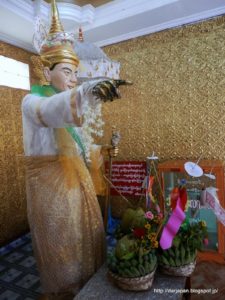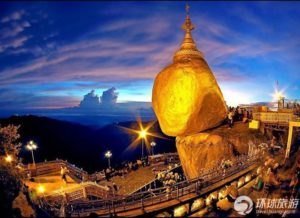Welcome to Myanmar!
you can get peaceful and amazing things when you travel around famous destination in Myanmar.
Such as Shwedagon Pagoda, Botathaung Pagoda (Botathaung Phoe Phoe Gyi), Golden Rock, Mandalay Royal City, Bagan ancient city, and the big lake and famous pagoda call Phoung Daw Oo in Inle Lake.
ชเวดากอง เจดีย์ ( ရွှေတိဂုံစေတီတော် , IPA : [ ʃwèdəɡòʊɴ pʰəjá ] ); ကျာ်လ္ဂုၚ် [ tɕaɪʔ təkɜŋ ] ชื่ออย่างเป็นทางการ ชเวดากอง Zedi นาง ([ ʃwèdəɡòʊɴ zèdìdɔ ] ) และ ยังเป็นที่รู้จัก เจดีย์ เดกอน ที่ดีและ โกลเด้น เจดีย์ เป็น เจดีย์ ทอง ตั้งอยู่ ในย่างกุ้ง พม่า 99 เมตร ( 325 ฟุต) [ ต้องการอ้างอิง] เจดีย์ ตั้งอยู่บน Singuttara ฮิลล์ ไปทางตะวันตกของ ทะเลสาบ Kandawgyi และ dominates เส้นขอบฟ้าของ เมืองย่างกุ้ง
ชเวดากอง เจดีย์ เป็น เจดีย์ พุทธ ศักดิ์สิทธิ์ที่สุด ในประเทศพม่า ซึ่งเป็นที่ เชื่อกันว่าจะ มี พระธาตุของ พระพุทธเจ้า สี่ ก่อนหน้า Kalpa ปัจจุบัน พระธาตุ เหล่านี้รวมถึง พนักงาน ของ Kakusandha กรอง น้ำ ของ Koṇāgamana ชิ้นส่วนของ เสื้อคลุม ของ กัสสปะ และ แปด เส้นของผม ออกมาจากหัว ของ องค์
The Shwedagon Pagoda (ရွှေတိဂုံစေတီတော်, IPA: [ʃwèdəɡòʊɴ pʰəjá]); ကျာ် လ္ဂုၚ်, [tɕaɪʔ təkɜ̀ŋ], officially named Shwedagon Zedi Daw ([ʃwèdəɡòʊɴ zèdìdɔ̀]) and also known as the Great Dagon Pagoda and the Golden Pagoda, is a gilded stupa located in Yangon, Myanmar. The 99 metres (325 ft) tall[citation needed] pagoda is situated on Singuttara Hill, to the west of Kandawgyi Lake, and dominates the Yangon skyline.
Shwedagon Pagoda is the most sacred Buddhist pagoda in Myanmar, as it is believed to contain relics of the four previous Buddhas of the present kalpa. These relics include the staff of Kakusandha, the water filter of Koṇāgamana, a piece of the robe of Kassapa, and eight strands of hair from the head of Gautama.
The Botataung Pagoda (Burmese: ဗိုလ်တထောင်ဘုရား [bòtətʰàʊɴ pʰəjá]; also spelled Botahtaung; literally “1000 military officers”) is a famous pagoda located in downtown Yangon, Myanmar, near the Yangon river. The pagoda was first built by the Mon around the same time as was Shwedagon Pagoda—according to local belief, over 2500 years ago, and was known as Kyaik-de-att in Mon language. The pagoda is hollow within, and houses what is believed to be a sacred hair of Gautama Buddha.[1]
The Botataung Pagoda was completely destroyed during World War II, and was rebuilt after the war.
Botataung Pagoda ( พม่า : ဗိုလ်တထောင်ဘုရား [ bòtətʰàʊɴ pʰəjá ] ; ยังสะกด โบตะตอง ; อย่างแท้จริง ” นายทหาร 1000 “) เป็น เจดีย์ ที่มีชื่อเสียง ตั้งอยู่ ในย่านใจกลางเมือง ย่างกุ้ง ประเทศพม่า ใกล้แม่น้ำ ย่างกุ้ง เจดีย์ ถูกสร้างขึ้น เป็นครั้งแรกโดย ชาวมอญ รอบในเวลาเดียวกัน เช่นเดียวกับ ชเวดากอง เจดีย์ ตาม ความเชื่อ ท้องถิ่น กว่า 2,500 ปีที่ผ่านมา และเป็นที่รู้จัก ในฐานะ Kyaik -de- ATT ในภาษา มอญ เจดีย์ กลวง ภายใน บ้านและ สิ่งที่เชื่อว่า จะเป็น ผม ศักดิ์สิทธิ์ ของ พระพุทธเจ้า . [1] เจดีย์ Botataung ถูกทำลาย ในช่วง สงครามโลกครั้งที่สอง และได้รับการ สร้างขึ้นมาใหม่ หลังสงคราม.
Kyaiktiyo Pagoda (Burmese: ကျိုက်ထီးရိုးဘုရား, pronounced: [tɕaiʔtʰíjó pʰəjá]; Mon: ကျာ်သိယဵု, [tɕaiʔ sɔeʔ jɜ̀], also known as Golden Rock) is a well-known Buddhist pilgrimage site in Mon State, Burma. It is a small pagoda (7.3 metres (24 ft)) built on the top of a granite boulder covered with gold leaves pasted on by devotees. According to legend, the Golden Rock itself is precariously perched on a strand of the Buddha‘s hair. The balancing rock seems to defy gravity, as it perpetually appears to be on the verge of rolling down the hill. The rock and the pagoda are at the top of Mt. Kyaiktiyo. It is the third most important Buddhist pilgrimage site in Burma after the Shwedagon Pagoda and the Mahamuni Pagoda. A glimpse of the “gravity defying” Golden Rock is believed to be enough of an inspiration for any person to turn to Buddhism
Kyaiktiyo Pagoda ( พม่า : ကျိုက်ထီးရိုးဘုရား เด่นชัด [ tɕaiʔtʰíjó pʰəjá ] ; มอญ : ကျာ်သိယဵု [ tɕaiʔ sɔeʔ jɜ ] ยังเป็นที่รู้จัก โกลเด้น ร็อค ) เป็น ที่รู้จักกันดี สถานที่แสวงบุญ ของชาวพุทธ ใน รัฐมอญ ประเทศพม่า มันเป็น เจดีย์ ขนาดเล็ก ( 7.3 เมตร (24 ฟุต) ) สร้างขึ้นบน หินแกรนิต ปกคลุมด้วย ทอง ใบ วางบน โดย วิหค ตามตำนาน ร็อค โกลเด้น ตัวเอง ตั้งอยู่ หมิ่นเหม่ บน เส้นผมของ พระพุทธรูป ของ หิน สมดุล ดูเหมือนว่าจะ ต่อต้านแรงโน้มถ่วง เป็นมัน ตลอด ดูเหมือนจะ หมิ่น กลิ้งลง เนินเขา หิน และเจดีย์ อยู่ที่ ด้านบนของ ภูเขา Kyaiktiyo มัน เป็นครั้งที่สาม ที่สำคัญที่สุด สถานที่แสวงบุญ ของชาวพุทธ ในพม่า หลังจากที่ เจดีย์ ชเวดากอง และ เจดีย์ Mahamuni เหลือบ ของ ” แรงโน้มถ่วง defying ” โกลเด้น ร็อค เชื่อว่าจะ เพียงพอ ของแรงบันดาลใจ ให้ผู้สนใจ ที่จะหันไป ทางพุทธศาสนา
The Mandalay Palace (Burmese: မန္တလေး နန်းတော်, pronounced: [máɴdəlé náɴdɔ̀]), located in Mandalay, Myanmar, is the last royal palace of the last Burmese monarchy. The palace was constructed, between 1857 and 1859 as part of King Mindon‘s founding of the new royal capital city of Mandalay. The plan of Mandalay Palace largely follows the traditional Burmese palace design, inside a walled fort surrounded by a moat. The palace itself is at the centre of the citadel and faces east. All buildings of the palace are of one storey in height. The number of spires above a building indicated the importance of the area below.[1]
Mandalay Palace was the primary royal residence of King Mindon and King Thibaw, the last two kings of the country. The complex ceased to be a royal residence and seat of government on 28 November 1885 when, during the Third Anglo-Burmese War, troops of the Burma Field Force entered the palace and captured the royal family. The British turned the palace compound into Fort Dufferin, named after the then viceroy of India. Throughout the British colonial era, the palace was seen by the Burmese as the primary symbol sovereignty and identity. Much of the palace compound was destroyed during World War II by allied bombing; only the royal mint and the watch tower survived. A replica of the palace was rebuilt in the 1990s with some modern materials.
Today, Mandalay Palace is a primary symbol of Mandalay and a major tourist destination
มั ณ ฑะเลวัง (พม่า: မန္တလေးနန်းတော်เด่นชัด [máɴdəlénáɴdɔ]) ที่ตั้งอยู่ในมั ณ ฑะเลพม่าเป็นพระราชวังสุดท้ายของสถาบันพระมหากษัตริย์พม่าที่ผ่านมา พระราชวังถูกสร้างขึ้นระหว่าง 1857 และ 1859 เป็นส่วนหนึ่งของกษัตริย์ Mindon ก่อตั้งของใหม่เมืองหลวงของราชวงศ์มั ณ ฑะเล แผนของพระราชวังมั ณ ฑะเลย์ส่วนใหญ่เป็นไปตามการออกแบบแบบดั้งเดิมพระราชวังพม่าภายในป้อมกำแพงล้อมรอบด้วยคูน้ำ พระราชวังที่ตัวเองเป็นศูนย์กลางของป้อมและใบหน้าตะวันออก ทุกอาคารของพระราชวังที่มีชั้นเดียวอยู่ในที่สูง จำนวนยอดแหลมเหนืออาคารที่ระบุถึงความสำคัญของพื้นที่ด้านล่าง. [1] พระราชวังมั ณ ฑะเลย์เป็นหลักพระที่นั่งของกษัตริย์ Mindon กษัตริย์ Thibaw ทั้งสองกษัตริย์สุดท้ายของประเทศ ที่ซับซ้อนหยุดที่จะพระที่นั่งและที่นั่งของรัฐบาลเมื่อวันที่ 28 พฤศจิกายน 1885 เมื่อในช่วงสงครามโลกครั้งที่สามแองโกลพม่ากองกำลังของสนามกองทัพพม่าเข้ามาในพระราชวังและจับพระราชวงศ์ อังกฤษเปิดสารประกอบพระราชวังลงในฟอร์ตดัฟตั้งชื่อตามอุปราชแล้วของประเทศอินเดีย ตลอดยุคอาณานิคมของอังกฤษพระราชวังก็เห็นพม่าเป็นสัญลักษณ์ของอำนาจอธิปไตยหลักและตัวตน มากของสารประกอบพระราชวังถูกทำลายในช่วงสงครามโลกครั้งที่สองระเบิดพันธมิตร; เพียง แต่มิ้นท์หลวงและหอนาฬิกาที่รอดชีวิต แบบจำลองของพระราชวังที่ถูกสร้างขึ้นมาใหม่ในปี 1990 ด้วยวัสดุที่ทันสมัยบาง วันนี้พระราชวังมั ณ ฑะเลย์เป็นสัญลักษณ์หลักของมั ณ ฑะเลและเป็นสถานที่ท่องเที่ยวที่สำคัญ
Bagan (Burmese: ပုဂံ; MLCTS: pu.gam, IPA: [bəɡàɴ]; formerly Pagan) is an ancient city located in the Mandalay Region of Myanmar . From the 9th to 13th centuries, the city was the capital of the Kingdom of Pagan, the first kingdom to unify the regions that would later constitute modern Myanmar. During the kingdom’s height between the 11th and 13th centuries, over 10,000 Buddhist temples, pagodas and monasteries were constructed in the Bagan plains alone, of which the remains of over 2200 temples and pagodas still survive to the present day.
The Bagan Archaeological Zone is a main draw for the country’s nascent tourism industry. It is seen by many as equal in attraction to Angkor Wat in Cambodia.
พุกาม ( พม่า : ပုဂံ ; MLCTS : pu.gam , IPA : [ bəɡàɴ ] ; เดิม Pagan ) เป็นเมืองโบราณ ที่ตั้งอยู่ใน เขตมั ณ ฑะเลย์ ประเทศพม่า ตั้งแต่วันที่ 9 เพื่อ ศตวรรษที่ 13 เมือง เป็นเมืองหลวง ของราชอาณาจักร อิสลาม ราชอาณาจักร คนแรก ที่จะรวมกัน ในภูมิภาค ในภายหลังว่า จะเป็นการ ที่ทันสมัย พม่า ในช่วงความสูง ของราชอาณาจักร ระหว่าง ศตวรรษที่ 11 และ 13 กว่า 10,000 วัดพุทธ เจดีย์ และพระราชวงศ์ ถูกสร้างขึ้น ใน ที่ราบ พุกาม คนเดียว ที่ เหลืออยู่ กว่า 2,200 วัดและ เจดีย์ ยังคง อยู่รอด มาจนถึงปัจจุบัน พุกาม โบราณคดี โซน เป็นวาด หลักสำหรับ อุตสาหกรรมการท่องเที่ยว ของประเทศ ตั้งไข่ จะเห็นได้ มากที่สุดเท่าที่ เท่าเทียมกันในการ ดึงดูดความสนใจของ นครวัด ใน กัมพูชา

People row long-boats with their legs to pull the Phaung Daw (Royal Boat), which is carrying statues of Buddha, during the annual 18-day Phaung Daw Oo festival at Inle Lake October 4, 2011. Inle Lake, Myanmar’s second largest lake, is located 2,980 feet (908 metres) above sea level at Shan Hills and is one of the country’s most popular tourist sites. The Phaung Daw Oo pagoda located on the Inle Lake houses five statues of Buddha gilded with gold leaf, which are believed to have been brought there by one of the kings of Bagan in the 11th century. REUTERS/Soe Zeya Tun (MYANMAR – Tags: RELIGION SOCIETY)
Inle Lake (Burmese: အင်းလေးကန်, pronounced: [ʔɪ́ɴlé kàɴ]) is a freshwater lake located in the Nyaungshwe Township of Taunggyi District of Shan State, part of Shan Hills in Myanmar (Burma). It is the second largest lake in Myanmar with an estimated surface area of 44.9 square miles (116 km2), and one of the highest at an elevation of 2,900 feet (880 m). During the dry season, the average water depth is 7 feet (2.1 m), with the deepest point being 12 feet (3.7 m), but during the rainy season this can increase by 5 feet (1.5 m).
The watershed area for the lake lies to a large extent to the north and west of the lake. The lake drains through the Nam Pilu or Balu Chaung on its southern end. There is a hot spring on its northwestern shore.
Although the lake is not large, it contains a number of endemic species. Over twenty species of snails and nine species of fish are found nowhere else in the world. Some of these, like the silver-blue scaleless Sawbwa barb, the crossbanded dwarf danio, and the Lake Inle danio, are of minor commercial importance for the aquarium trade. It hosts approximately 20,000 brown and black head migratory seagulls in November, December and January.[1]
In June 2015, it becomes the Myanmar’s first designated place of World Network of Biosphere Reserves.[2] It was one of 20 places added at at the Unesco‘s 27th Man and the Biosphere (MAB) International Coordinating Council (ICC) meeting.
ทะเลสาบอินเล (พม่า: အင်းလေးကန်เด่นชัด [ʔɪɴlékàɴ]) เป็นทะเลสาบน้ำจืดที่ตั้งอยู่ในเขตการปกครองของ Nyaungshwe
ตองยีเขตรัฐฉานฉานส่วนหนึ่งของฮิลส์ในพม่า (พม่า) มันเป็นทะเลสาบที่ใหญ่เป็นอันดับสองในประเทศพม่าที่มีพื้นที่ผิวประมาณ
44.9 ตารางไมล์ (116 กิโลเมตร 2) และเป็นหนึ่งในที่สูงที่สุดที่ระดับความสูง 2,900 ฟุต (880 เมตร)
ช่วงฤดูแล้งที่น้ำลึกเฉลี่ยอยู่ที่ 7 ฟุต (2.1 เมตร) มีจุดที่ลึกที่สุดเป็น 12 ฟุต (3.7 เมตร) แต่ในช่วงฤดูฝนนี้จะเพิ่มขึ้น
5 ฟุต (1.5 เมตร)
พื้นที่ลุ่มน้ำทะเลสาบอยู่ในระดับใหญ่ไปทางทิศเหนือและทิศตะวันตกของทะเลสาบ ท่อระบายน้ำทะเลสาบผ่านน้ำ
Pilu หรือ Balu Chaung บนปลายภาคใต้ มีน้ำพุร้อนบนชายฝั่งตะวันตกเฉียงเหนือของมันคือ
แม้ว่าทะเลสาบมีขนาดไม่ใหญ่ก็มีจำนวนของสายพันธุ์ถิ่น
กว่ายี่สิบชนิดของหอยทากและเก้าชนิดของปลาจะพบว่าไม่มีที่ไหนในโลก เหล่านี้บางส่วนเช่นสีเงินสีฟ้าล้มคว่ำ
Sawbwa ขวากหนามที่ crossbanded Danio แคระและ Danio ทะเลสาบอินเล, มีความสำคัญในเชิงพาณิชย์เล็ก ๆ น้อย ๆ
สำหรับการค้าพิพิธภัณฑ์สัตว์น้ำ มันเป็นเจ้าภาพประมาณ
20,000 น้ำตาลและสีดำหัวนกนางนวลอพยพในเดือนพฤศจิกายนเดือนธันวาคมและมกราคม.
ในเดือนมิถุนายนปี 2015 มันจะกลายเป็นสถานที่ที่กำหนดของพม่าครั้งแรกของเครือข่ายทั่วโลกของเขตสงวนชีวมณฑล.
มันเป็นหนึ่งใน 20 สถานที่ที่เพิ่มผู้ชาย 27 ยูเนสโกและชีวมณฑล (MAB) คณะมนตรีประสานงานระหว่างประเทศ
(ICC) ที่ประชุม.
If somethings wrong kindly and apologizes for Google Translate.
Thank You.
You can contact us every-time by email and Viper.
NOo.(180), U Chit Maung Rd, Bahan Tsp, Yangon.
+951 544 277
+959 7878 111 22
+959 78 2220 681~5
admin2@wingsinternationaltravels.com
operation@wingsinternationaltravels.com
sales2@wingsinternationaltravels.com








Comments